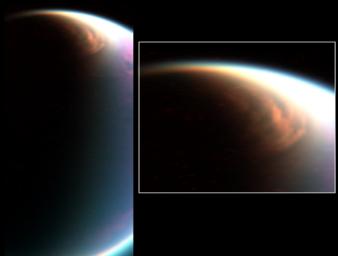
|
Titan’s Giant North Pole Cloud
- Click the image above for a larger view
- Full-Res JPEG (991 x 752) (30.9 kB)
- Full-Res TIFF (991 x 752) (2.2 MB)
Caption:
Cassini's visual and infrared mapping spectrometer has imaged a huge cloud system covering the north pole of Titan.
This composite image shows the cloud, imaged at a distance of 90,000 kilometers (54,000 miles) during a Dec. 29, 2006, flyby designed to observe the limb of the moon. Cassini's visual and infrared mapping spectrometer scanned the limb, revealing this spectacular cloud system. It covers the north pole down to a latitude of 62 degrees north and at all observed longitudes.
Such a cloud cover was expected, according to the atmospheric circulation models of Titan, but it had never been observed before with such details. The condensates may be the source of liquids that fill the lakes recently discovered by the radar instrument. This image was color-coded, with blue, green and red at 2 microns, 2.7, and 5 microns, respectively.
Background Info:
The Cassini-Huygens mission is a cooperative project of NASA, the European Space Agency and the Italian Space Agency. The Jet Propulsion Laboratory, a division of the California Institute of Technology in Pasadena, manages the mission for NASA's Science Mission Directorate, Washington, D.C. The Cassini orbiter was designed, developed and assembled at JPL. The Visual and Infrared Mapping Spectrometer team is based at the University of Arizona where this image was produced.
For more information about the Cassini-Huygens mission visit http://saturn.jpl.nasa.gov/home/index.cfm . The visual and infrared mapping spectrometer team homepage is at http://wwwvims.lpl.arizona.edu .
Cataloging Keywords:
| Name | Value | Additional Values |
|---|---|---|
| Target | Titan | |
| System | Saturn | |
| Target Type | Satellite | |
| Mission | Cassini-Huygens | |
| Instrument Host | Cassini Orbiter | |
| Host Type | Orbiter | |
| Instrument | Visual and Infrared Mapping Spectrometer (VIMS) | |
| Detector | ||
| Extra Keywords | Atmosphere, Color, Infrared, Radar | |
| Acquisition Date | ||
| Release Date | 2007-02-01 | |
| Date in Caption | 2006-12-29 | |
| Image Credit | NASA/JPL/University of Arizona/LPGNantes | |
| Source | photojournal.jpl.nasa.gov/catalog/PIA09171 | |
| Identifier | PIA09171 | |
